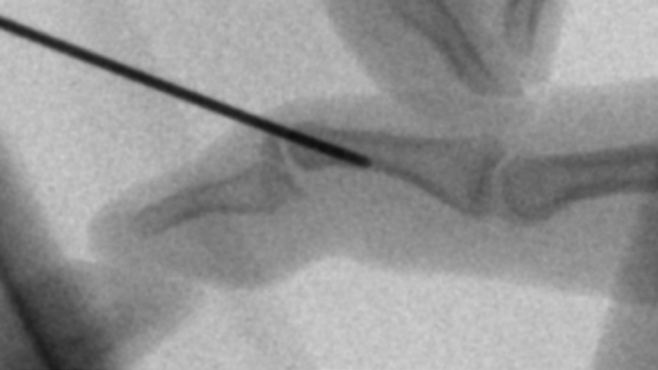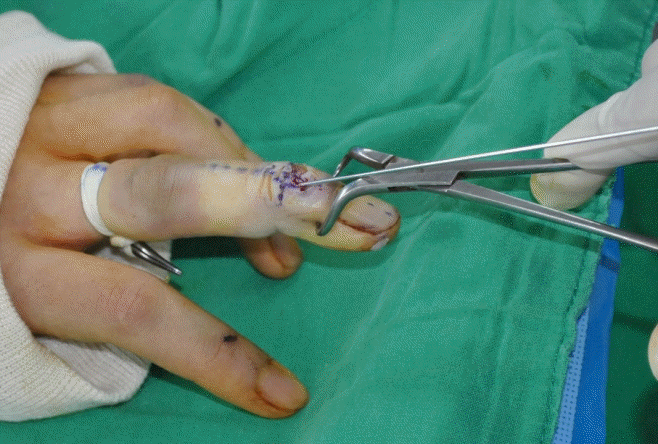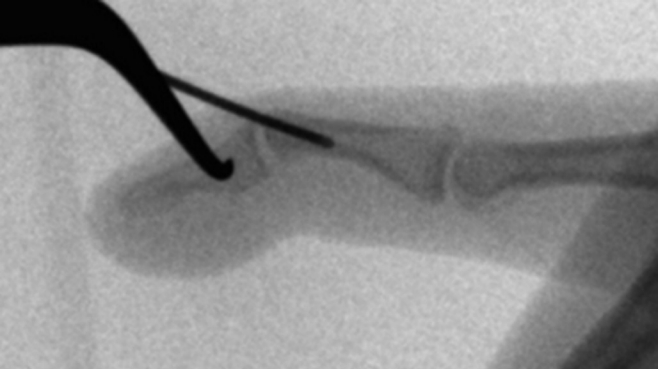This article has been
cited by other articles in ScienceCentral.
Abstract
Purpose
Although closed reduction and extension block pinning have been widely used for acute mallet finger fracture, the problem of reduction remains a concern. We describe a tip for the reduction technique using a towel clamp, which provides a longitudinal traction force to the distal phalanx, and report the results of the technique.
Methods
The medical records of 14 consecutive cases from 12 patients with acute mallet fractures were retrospectively reviewed. Reduction was achieved using the towel clamp reduction technique. The radiologic results were evaluated by simple radiographs, the functional results were analyzed in terms of range of motion, and remaining pain was assessed using Crawford criteria.
Results
The mean follow-up period was 8.4 months. The mean union duration was 6 weeks. The mean range of motion was 73°. Eight cases had excellent outcomes, one had good outcomes, four had fair outcomes, and one had poor outcomes. One case of superficial infection and one case of skin necrosis developed, and three cases showed arthritic changes in the distal interphalangeal joint.
Conclusion
The towel clamp technique can provide good reduction during surgery, with favorable radiologic and clinical results.
Go to :

Keywords: Finger Phalanges, Closed Fracture Reduction, Traction, Surgical Clamps
Introduction
Although surgical treatment for mallet fracture has been controversial, closed reduction with extension block Kirschner wire (K-wire) fixation has been widely used as a treatment of choice for acute mallet fracture [
1,
2]. Despite the efficacy and convenience to perform the procedure, several authors have expressed worries on the reduction issue [
3,
4]. To eliminate this difficulty, Chung and Lee [
3] used additional intrafocal pinning and Lee et al. [
4] used two thinner K-wires. However, it may decrease the advantage of less invasiveness of the original extension block pinning by using more than two K-wires. The original extension block pinning causes hyperextension to reduce the fracture fragment. However, usually, the subluxated distal phalanx does not return to its original position by extension only. Moreover, simple hyperextension may worsen the problem, creating a wider gap in the articular surface.
To reduce the displaced and overlapping bony fragments, a longitudinal traction force may be helpful. Here, we describe a simple technique using a towel clamp to generate a longitudinal traction force and reduce the distal phalanx.
Go to :

Methods
Ethics statement: This study was approved from the Institutional Review Board of Kyungpook National University Hospital (No. 2023-04-040). The study was performed in accordance with the Declaration of Helsinki, and written informed consent was waived due to its retrospective nature.
The medical records of patients who underwent extension block pinning at the Kyungpook National University Hospital in Daegu, Korea from January 2013 to December 2022 were retrospectively reviewed. Patients with acute mallet fracture less than 2 weeks after the injury were included. After excluding patients with a follow-up period of fewer than 3 months, 14 cases from 12 patients were included in this study. Reduction was achieved using the towel clip reduction technique. The radiologic results including arthritis, malunion, and nonunion were evaluated by simple radiographs. The clinical results were described using Crawford criteria by measuring extension lag and remaining pain.
The surgical procedure was similar to that previously described by Inoue [
1], except for the use of intraoperative traction, and the surgery was performed under digital block anesthesia. A rubber finger tourniquet using a surgical glove was placed at the base of the finger. Next, a 0.045-inch (1.1-mm) K-wire was inserted obliquely from the dorsal aspect of the middle phalanx with the distal interphalangeal (DIP) joint flexed at 45°. Reduction was attempted by extending the DIP joint (
Fig. 1). If reduction was not achieved only by DIP joint extension and joint incongruency occurred, longitudinal traction was applied. To exert a direct longitudinal traction force on the distal phalanx, a small towel clamp was applied so that the two tips gripped the distal phalanx. At this time, the tips of the towel clamp should be located at dorsolateral, between bilateral midline of distal phalanx and nail bed, to prevent damage to the nail bed and the proper palmar digital nerve and its dorsal branch (
Fig. 2). The towel clip should firmly catch the distal phalanx to avoid soft tissue tearing. While maintaining longitudinal traction using a towel clamp, the DIP joint was extended or hyperextended until the fracture was reduced (
Fig. 3); then, another 0.045-inch (1.1-mm) K-wire was inserted from the lateral side of the distal phalanx to fix the DIP joint. An aluminum finger splint was applied to immobilize the DIP joint until the pain subsided. At 6 weeks postoperatively, the K-wires were removed (
Fig. 4).
 | Fig. 1.Reduction using hyperextension after extension block wire insertion. The gap is not properly reduced. 
|
 | Fig. 2.Longitudinal traction of the distal phalanx with a towel clamp. 
|
 | Fig. 3.While maintaining longitudinal traction using a towel clamp, the distal interphalangeal joint is extended. A fluoroscopic image shows reduction of the fracture. 
|
 | Fig. 4.A 17-year-old patient presenting with mallet finger fracture with a large proximal bone fragment and subluxation of the distal phalanx (Wehbe and Schneider type IIB). Comparison of plain radiographs: preoperative (A), postoperative (B), and after pin removal (C). 
|
Go to :

Results
Fourteen cases from 12 patients (nine male and three female ) with a mean age of 36 years (range, 14–65 years) were treated using the towel clamp technique. Seven fractures were in the right hand, and seven were in the left hand, with the middle finger being most commonly affected (eight cases), followed by the little finger (three cases) and the fourth finger (three cases). The mean time between the injury and surgery was 6.7 days (range, 1–11 days).
The mean follow-up period was 8.4 months (range, 3–48 months), with all K-wires removed after 6 weeks. However, union was incomplete after 6 weeks in one patient, so the orthoses were retained until the union. Radiographic bone union was achieved in all cases by an average of 40 postoperative days (range, 35–50 days). At the final follow-up, the mean range of motion was 73° and the average extension deficit was 4.3° (range, 0°–20°).
Based on Crawford criteria, eight cases had excellent results, one had good results, four had fair results, and one had poor results. One patient with a poor result reported persistent pain and flexion limitation of 45° at the final follow-up. Three patients showed arthritic change at DIP joint osteoarthritis. There were no severe complications, such as comminution of the fracture fragment, nail deformity, volar subluxation, and dislocation. One patient developed superficial infection, and one developed skin necrosis; all were treated with oral antibiotics and wound care, as needed.
Go to :

Discussion
The treatment modality for mallet fracture of the finger is still controversial, and several authors have described different surgical techniques [
5]. Among various surgical modalities, extension block pinning is a less invasive technique than open reduction and internal fixation and has been widely used for mallet fracture [
6,
7]. The main concept of reduction is the use of extension block pin and hyperextension. Hyperextension is sometimes inadequate to reduce the fracture because the injury mechanism usually contains a compression force. Moreover, in situations of large fragments and volar subluxation, translation to the volar side is aggravated by the force of the flexor digitorum profundus.
Only hyperextension in the original technique does not have the longitudinal traction vector. If the rotation pivot is located proximal to the distal end of the dorsal fragment, hyperextension might cause a wider gap at the articular surface. In retrospective study, Hofmeister et al. [
8] reported that fracture displacement occurred after extension block pinning in two of 24 mallet fractures. Suh et al. [
9] retrospectively reviewed 35 cases of bony mallet fracture treated by extension block K-wire fixation and reported 10 cases with postoperative displacement of more than 1 mm. Several other authors have revealed the disadvantages of simple extension block pinning concerning reduction failure. To overcome the difficulties in reduction, they have described techniques with additional K-wires or using towel clips [
3-
5,
10]. However, the additional use of K-wires or clipping may disturb the less invasiveness of extension block pinning. To enhance the reduction of mallet finger fractures, we applied longitudinal traction force to the distal phalanx without additional K-wires. At both dorsolateral aspects of the distal phalanx, no major neurovascular structures can be damaged by the sharp tips of the towel clamp, except tiny vessels that anastomose between the dorsal and volar arches of the vessels. Clipping the distal phalanx with a towel clamp at the dorsolateral aspect of the distal phalanx seems safe at these points. The limitation of this study is this can be only performed in a retrospective manner. In addition, the number of cases is small, and the follow-up period is relatively short. Accordingly, further research appears to be necessary.
Go to :

Conclusion
Hyperextension is inadequate for treating mallet fractures in some situations. By applying a longitudinal traction force with a small towel clamp, mallet finger fractures can be more easily treated with extension block pinning. The towel clamp technique can provide good reduction during surgery with favorable radiologic and clinical results.
Go to :


